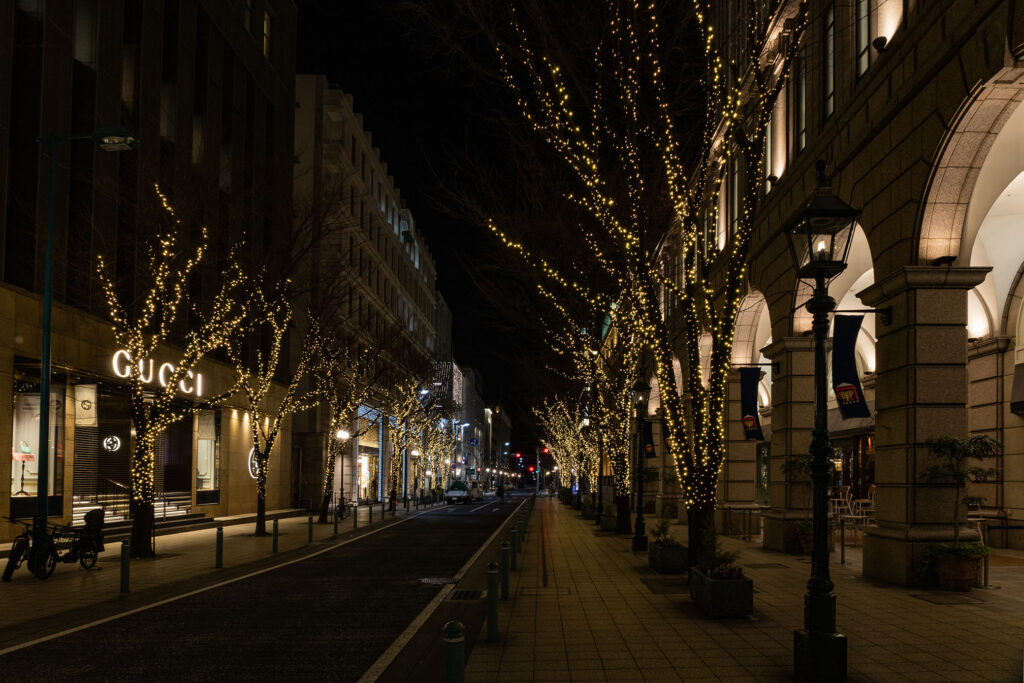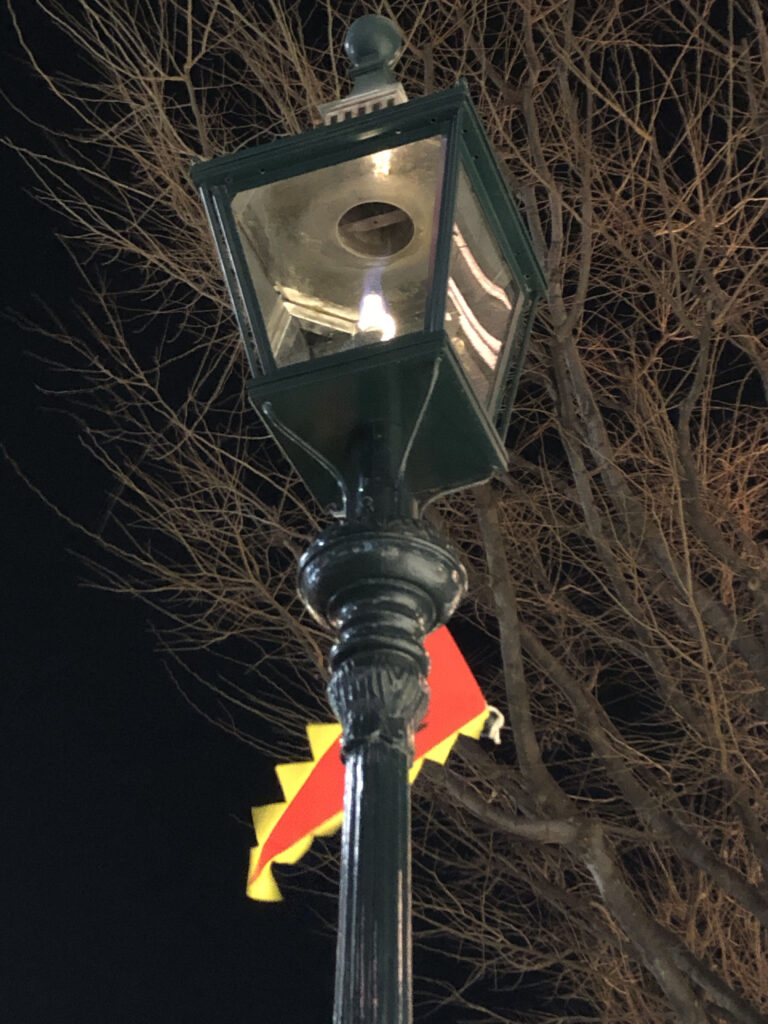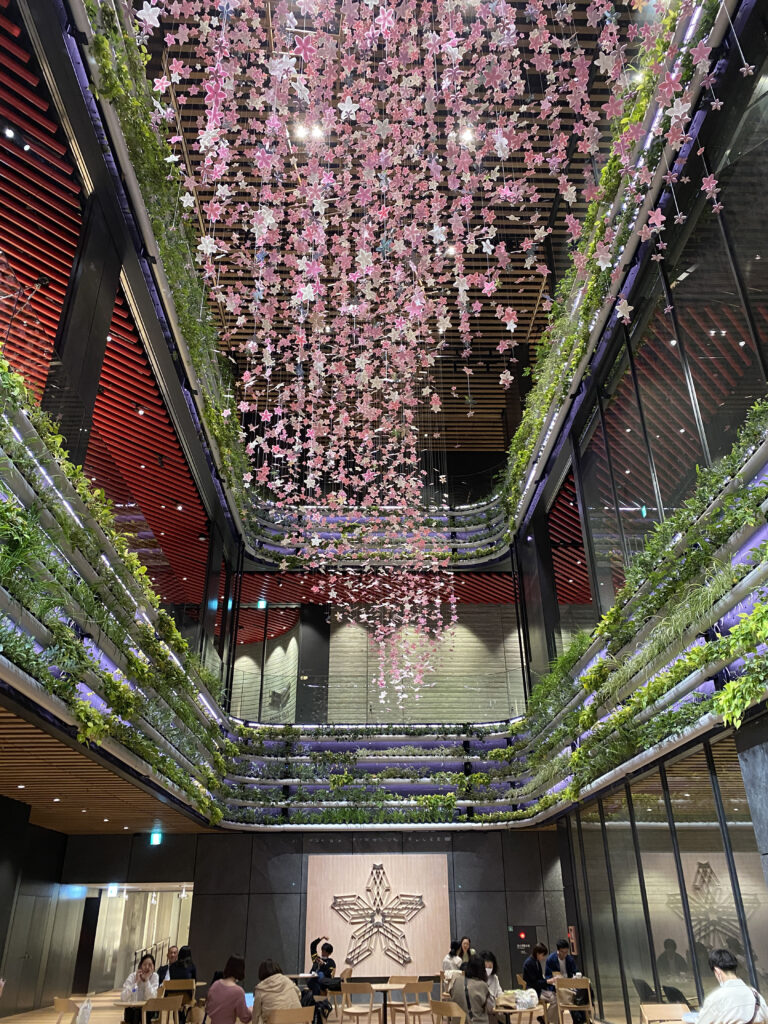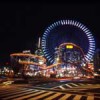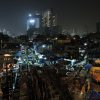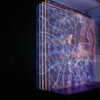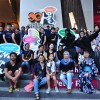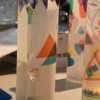Date of Issue: July 11, 2023
・Activity 1/ City Night Survey: Kobe(2023.01.18-01.20)
・Activity 2/ Night Walk Vol.71: Yaesu and Otsu(2023.03.24 & 04.21)
・Activity 3/Round Table Discussion Vol.69: Review on Yaesu and Otsu(2023.04.28)
City Night Survey: Kobe
2023.01.18-01.20 Yumi Honda + Misuzu Nakamura
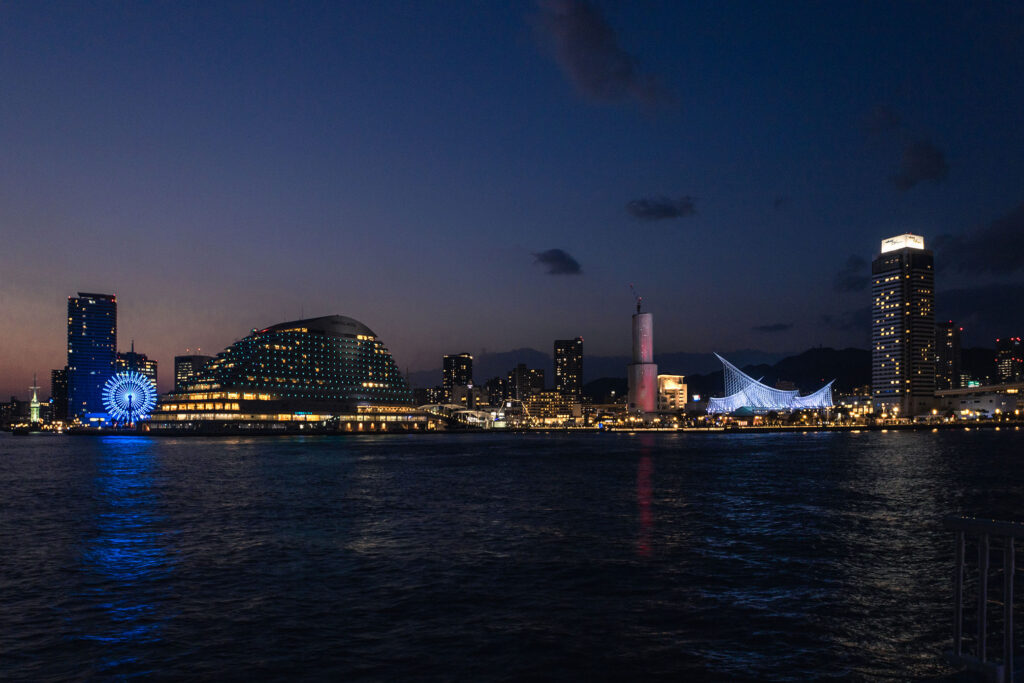
Unfortunately, the Port Tower is undergoing renovation, and the projection on the temporary enclosure is underway.
Kobe is famous for the night view from Mt. Rokko as the “10 Million Dollar Nightscape” and for its waterside nightscape as a port city. Nightscape guidelines have been established in 2012, and efforts are being actively made to improve the lighting in the city. We walked around the city, which continues to be updated, and explored the components of a nightscape that is uniquely Kobe.
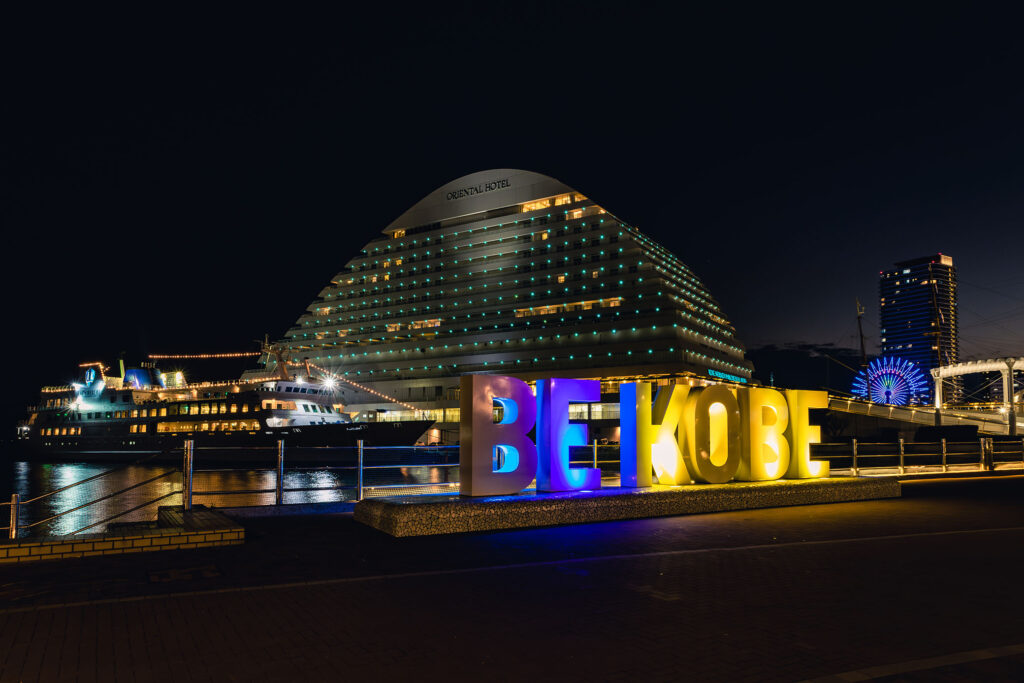
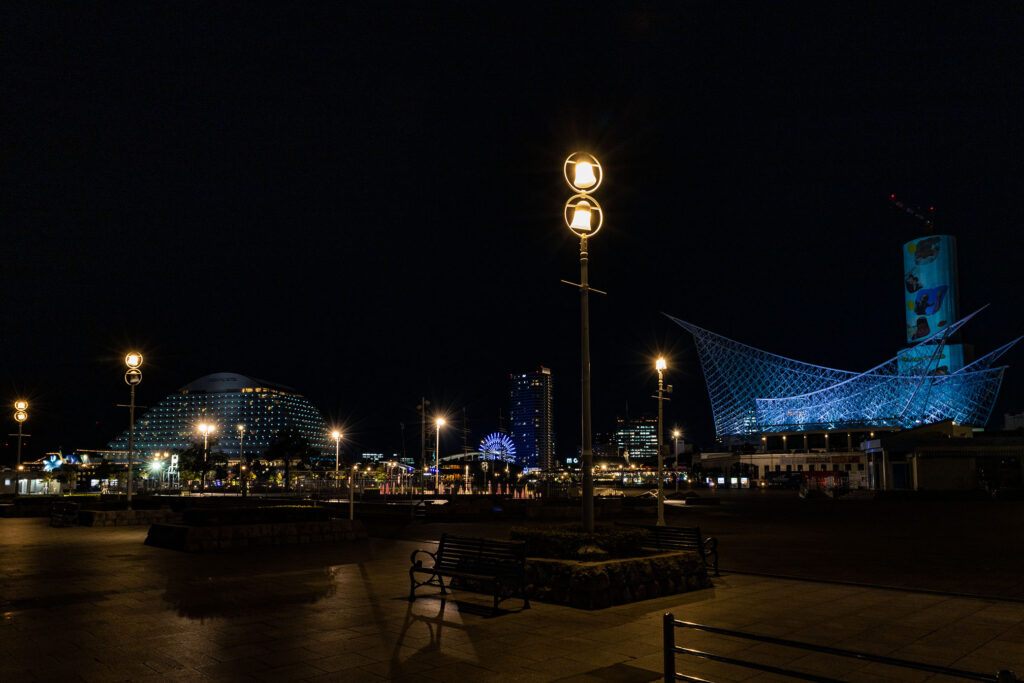
■“Instagrammable” Nightscape
Port Tower, Maritime Museum, Oriental Hotel, Hotel Okura, Ferris wheel, sightseeing boats, and the “BE KOBE” monument…. When people think of the city of Kobe, they probably think of Meriken Park. Meriken Park is the face of Kobe, and even at night many people were visiting the park to take commemorative photos. Many of the park’s symbolic monuments were lit up and color lighting was used extensively, but the colors and color schemes were mainly neutral, not primary colors, so it was nice to enjoy the colorful light without getting an overpowering impression. To complement the color lighting, the ground lights of the pole lights, handrail lights, and bollard lights were uniformly lit with light bulbs, creating a subdued brightness. Both decorative lighting and functional lighting emitted little excessive glare, allowing us to concentrate on the illuminated objects. It seemed like seeing the nightscape and taking pictures of it could be the purpose of a visit to this place. In this age of breathlessly uploaded photos and videos on Instagram and TikTok, “Instagrammable” has become a common concept that everyone is aware of on a daily basis. The night view of Meriken Park is the perfect place for those of us who want to “take a fancy nightscape photo!” At spots where we can take photogenic photos, such as in front of BE KOBE, there are several “recommended to take photos from here” signs posted at our feet. If you stand there and hold your camera up, you can capture the night view of Kobe, from the foreground to the lights in the background and the reflection of the lights on the sea surface beyond. It was impressive to see visitors enjoying themselves, taking photos and selfies with each other.
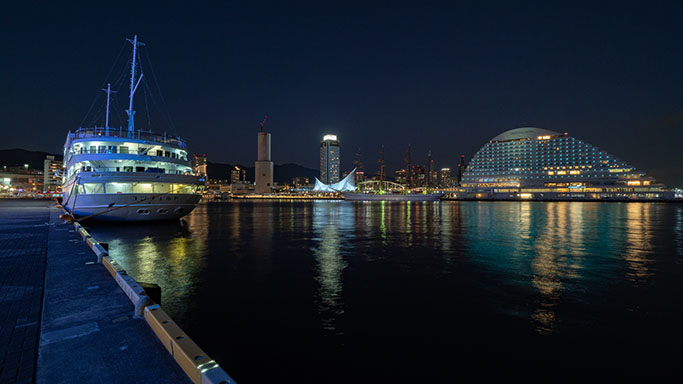
In order to showcase the photogenic landscape, the viewpoints that serve as photo shooting points seem to have been consciously maintained. The sightseeing map of Kobe City showed a lineup of recommended photo points, including “Daiichi(first) Jetty” just across the river and “Port Island North Park” across the Kobe Grand Bridge. However, when I went there, I found that compared to the bustling Meriken Park and Harbor Land, there were almost no people there both day and night. Both of these spots were good spots to enjoy panoramic night views of the seaside with lights reflected on the water, but I got the impression that they were still in the process of being marketed. Looking at the night view of the seaside from a distant viewpoint, one notices symbolic logos glowing in the background of the mountain range. These logos were positioned as ice stops at the end of the main street when walking through the city. Every detail of Kobe’s nightscape has been calculated to be “seen”. (Misuzu Nakamura)
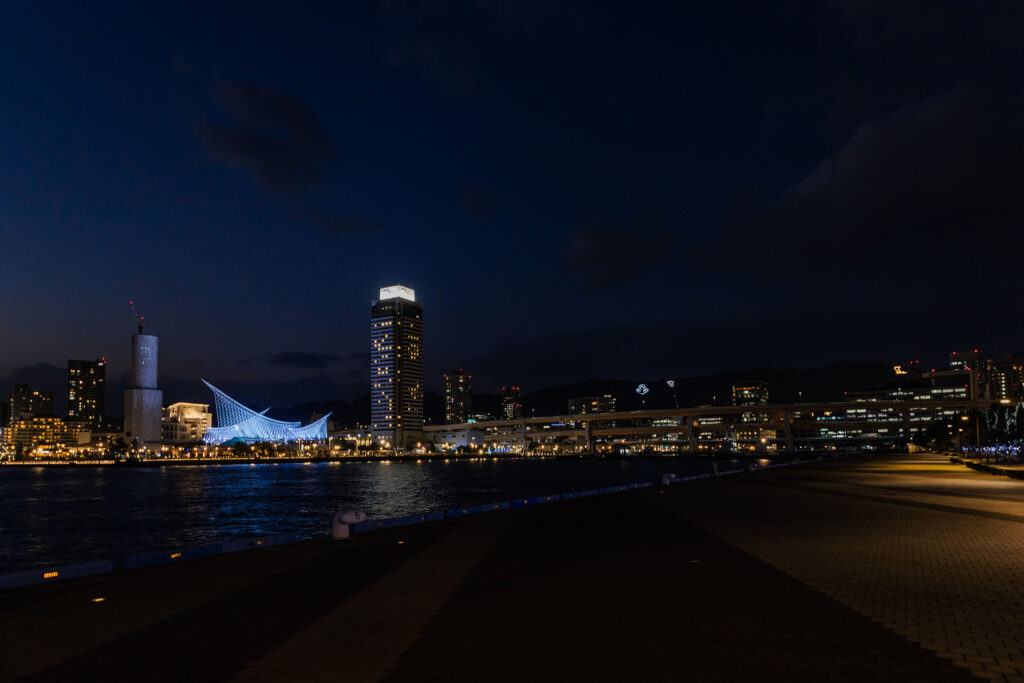
■Lights in the city that create the impression of Kobe
In addition to the waterfront scenery, the image often associated with Kobe is that of an exotic, sophisticated, and fashionable port city. As lighting elements, light bulbs and streetlight designs are solid, but there must be something subtle about the urban Kobe. We walked around at night from Sannomiya to Motomachi to investigate its secret.
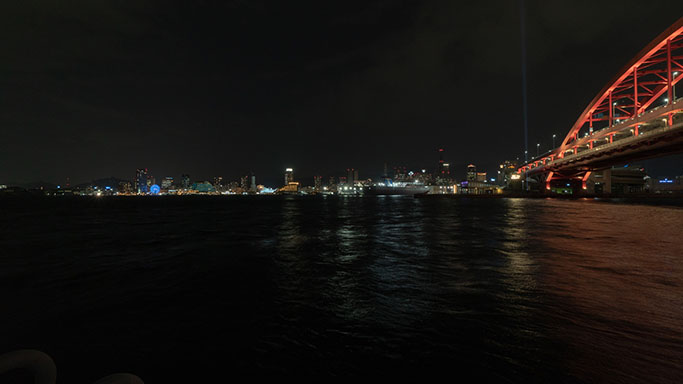
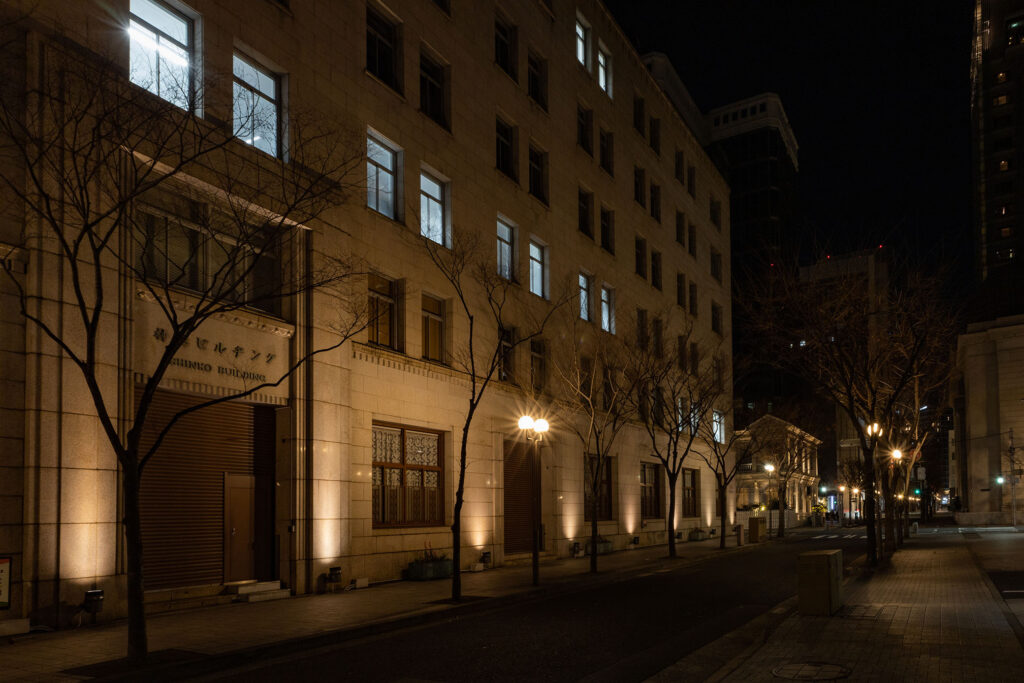
■Light of Designed City (Flower Road)
Flower Road is a major road from Shin-Kobe Station through Sannomiya Station to the sea. As is typical station fronts in large cities, the streets around Sannomiya Station are bright and shining white, but from the City Hall to the south, the entire street has a calm atmosphere as if it were part of a park.
This area was first developed in 2015, shortly after the “Nightscape Implementation Plan” was formulated. The roadway lights are light bulbs, which is unusual for an arterial road, and the low intensity setting makes the area seem dark for a moment, but the softly glowing pole lights and the lighting of colorful flowers and grasses create a lively atmosphere, guiding the eye. The color temperature consideration, glare-less roadway lights, luminance effects on vertical surfaces, RGB control, etc., carefully reflect the basics of nightscape maintenance, and convey an awareness of the goal of creating an elegant and sophisticated nightscape. Kobe East Park, which at the time of the 2005 survey was described as “just a dark mass of darkness” and “disappointed that it is so desolate at night because it is a pleasant place during the day,” has been transformed into “a pleasant place both day and night,” with citizens taking a break during their walks even on cold winter evenings.
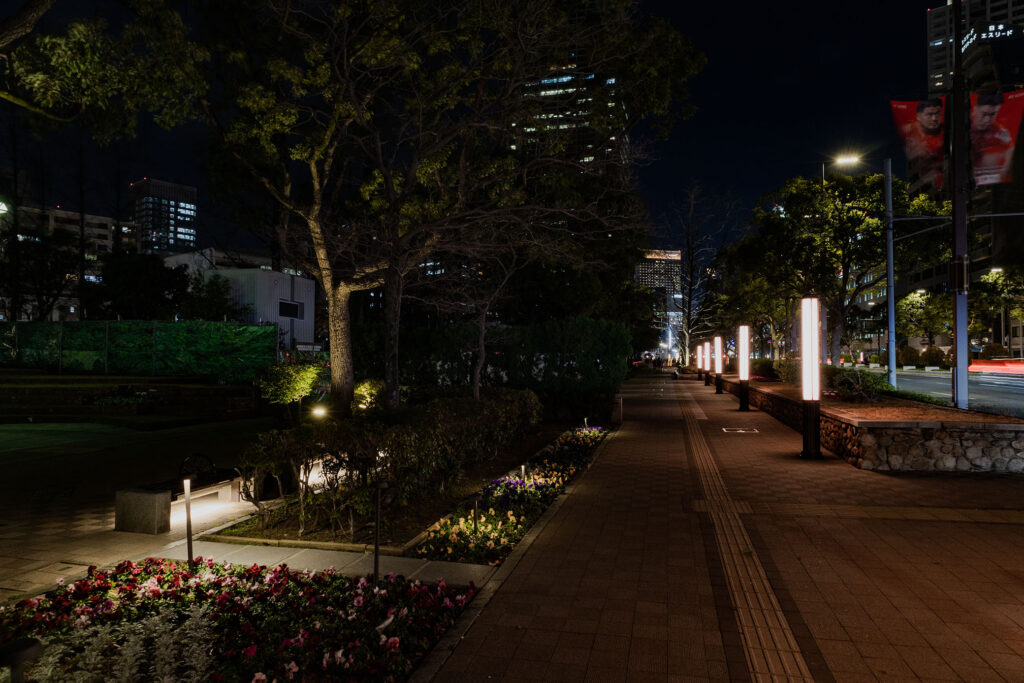
■Lights of Exoticism (Former Foreign Settlement – Nankinmachi Town)
Settlement, Western culture, Chinatown, architecture with a historical flavor… Kobe and Yokohama share the same characteristics as port towns, and both cities have been quick to develop lighting that enhances the city’s features, such as lighting up historical buildings, streetlights and lantern decorations with Chinese and Western designs. In the Old Settlement area, where retro modern buildings from the Taisho and Showa periods make up the streetscape, gas lamps have been installed in the Kobe City Museum and Kobe Daimaru blocks, but surprisingly, the other streets are mainly lit by spherical globe streetlights. The clear glass shades allow the lamps to be seen from all directions, and I was concerned about glare, but the shimmering light accentuates the stately streetscape and is effective in softly illuminating walls with little window area. The lanterns and red flags in Nanjing Town give a sense of Chinese New Year exuberance, just as one would expect in Chinatown. The lanterns attract the viewer’s attention not only to the individual stores, but also to the nightscape of the entire town. The boundary between Western and Chinese neighborhoods, each with its own distinct character, tends to be complicated, but by placing a Scandinavian-designed street lamp in the middle of the street, the atmosphere of a fashionable port town was created.
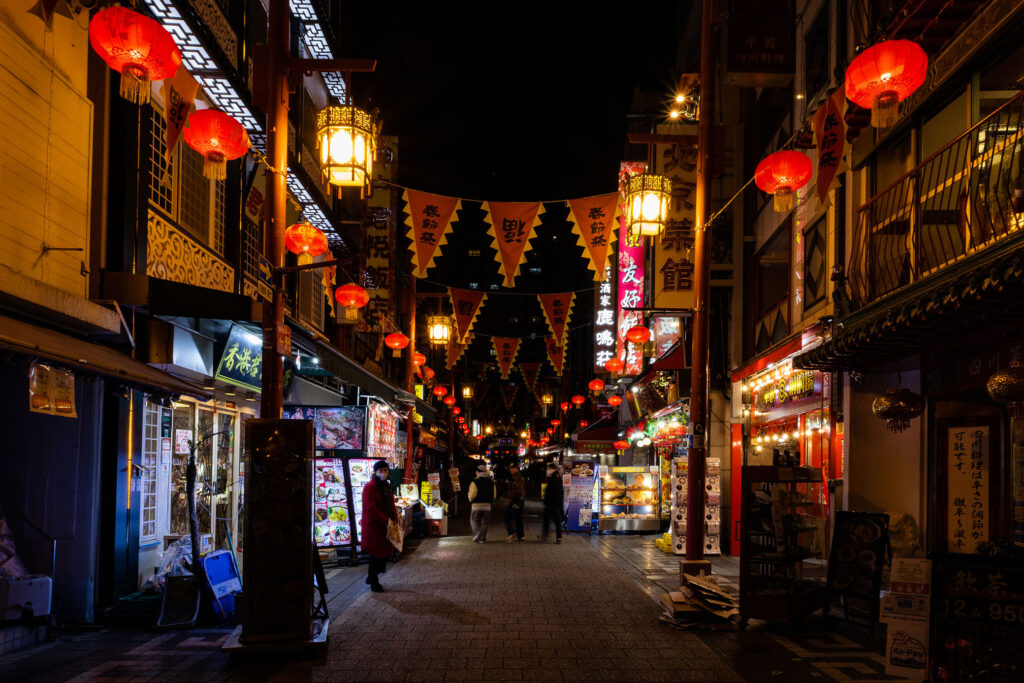
■Light succeeding to the townscape
After surveying the “Kobe-like” streets, we headed north to the station area, where the color temperature and illumination became much higher and the visual information content increased with colorful advertisements and billboards. The cumbersome appearance of the downtown area made us realize how effective the nightscape guidelines had been in other districts. In the priority areas of the guidelines, excessive lighting was first eliminated in favor of light bulb colors, low contrast between light and dark, and low brightness. In the downtown area in front of the station, a redevelopment project is underway in the vicinity of Sannomiya Station. The area around Sannomiya Station on the railroad line is an urban transportation network, and until now, one did not feel that one was in Kobe until one went to Meriken Park.
However, before the Great Hanshin-Awaji Earthquake, the station was the gateway to Kobe, creating the city’s image. The new Kobe Sannomiya Hankyu Building is a
reconstruction design of the Kobe Hankyu Building, the symbol of Kobe before the earthquake, with a retro arched window design on the facade and cobblestone streets, and the restrained color temperature and lighting create a pleasant street.
Thus, in the city of Kobe, there is a mixture of newly reconstructed buildings and streetlights that look like they have been there for a long time, such as the buildings in the Old Settlement area and Kobe Daimaru. While it should be easy to incorporate cuttingedge lighting technology and fads, I saw many places lit by real old-fashioned gas lamps. Although they are only modestly bright as urban sidewalk lights, the flickering small flames are warm and evocative of the mysteriousness of the night. I was pleased to see that they are not only updating the latest designs, but also placing importance on following the characteristics and memories of the city, and that they recognize the elements of streetlights and light as elements that create the streetscape. (Yumi Honda)
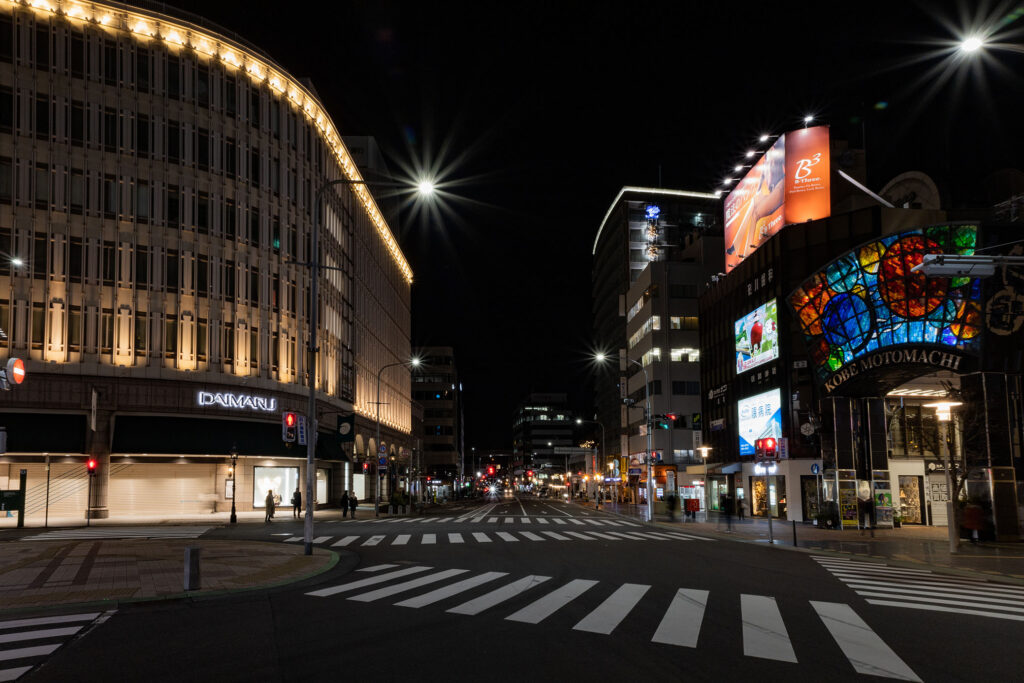
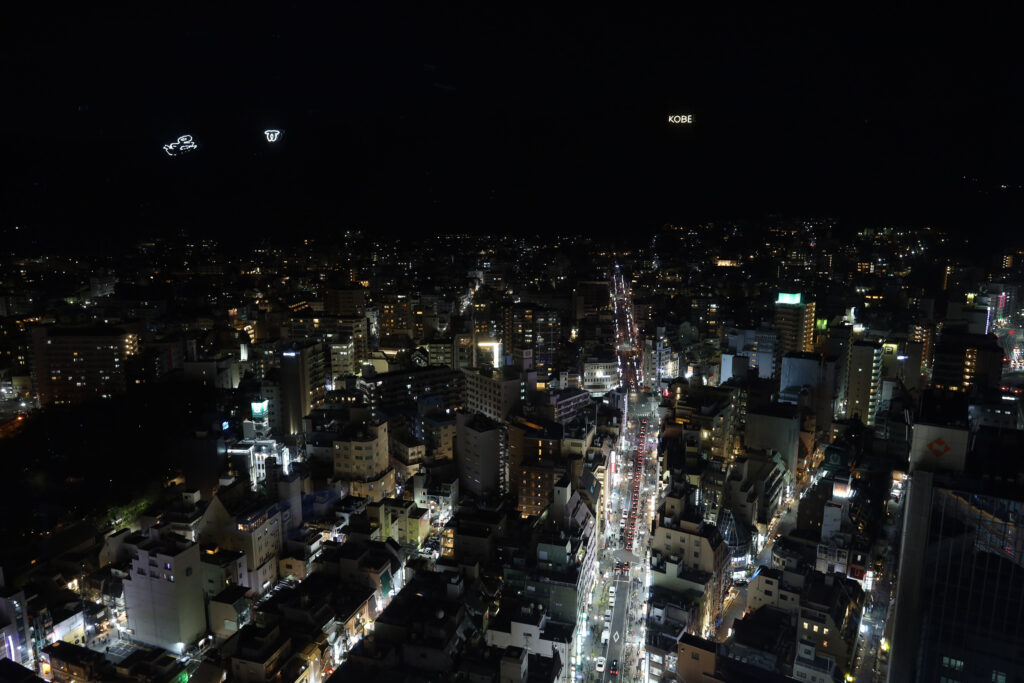
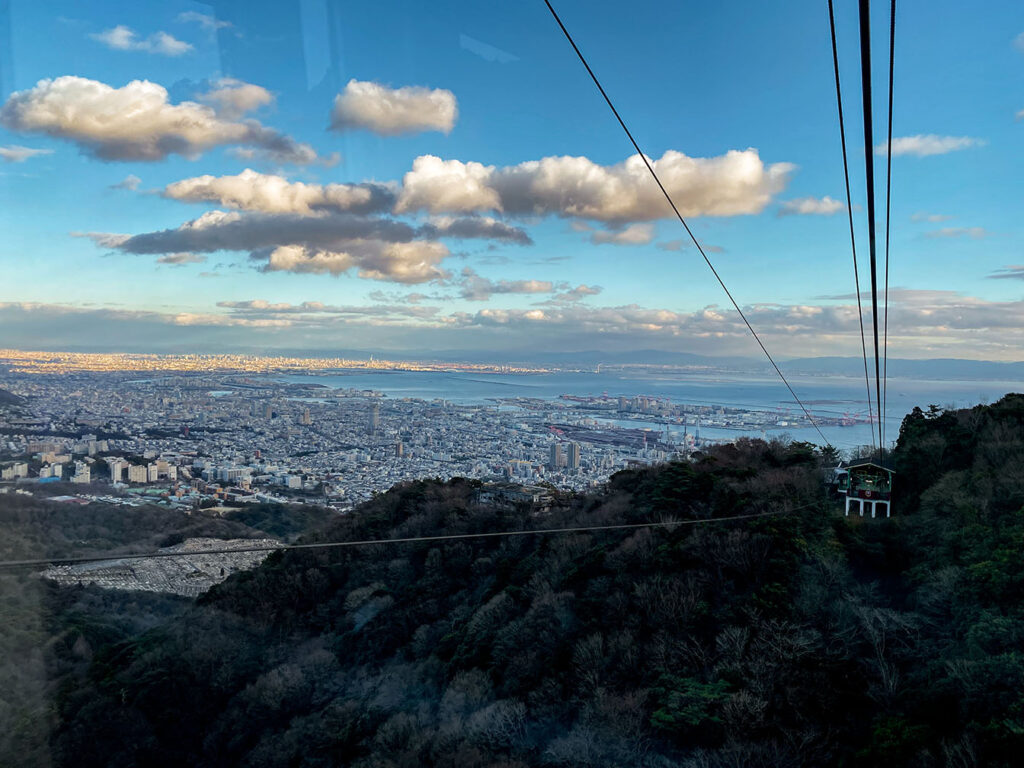
■Panorama with bird’s eye view
From the Suku-seidai Observatory, located at the highest point of Mt. Maya, which is linked to Mt. Rokko, visitors can enjoy a panoramic view of the city of Kobe at the edge of their field of vision, and as far as the Kii Peninsula surrounding Osaka Bay. The “Maya View Line” to the observatory was more crowded after dark than during the daytime, suggesting the popularity of the “night view from the observatory” as an established nighttime activity in Kobe. From Sukuji-dai, the lights of Kobe are a bit far away, so it is difficult to make out the illuminated buildings and streets in detail. However, the amount of light was overwhelming, and one could see a very wide area of the city lights stretching all the way to Osaka without feeling the lights were too glaring or uneven. I felt the distance to the city lights was similar to the night view from Mt. Moiwa to Sapporo. In contrast to Sapporo where the lights were mainly from street lamps with a sense of unity, in Kobe the lights from the windows of the buildings and the lights from the factories in the coastal area were of different colors and intensities, and there was a sense that the city’s activities were conveyed more clearly. Also, in Nagasaki, which, like Kobe, has a topography with slopes rising up near the sea, the spread of houses and roads on the slopes as well as on the plains creates a “three-dimensional nightscape” with lights on the slopes, whereas in Kobe, the mountain range has almost no light elements. Instead, from a viewpoint suitable for looking down on the plain, visitors can experience a “nightscape scattered over an area” with a panoramic view unobstructed by the surrounding slopes. While the city center was meticulously maintained in accordance with the guidelines, for the distant view along the sea and the bird’s eye view from the observatory, which are major landscapes, the impression was that the focus was on the development of viewpoints by utilizing the geographical potential rather than on the development of any additional lighting. We felt that the beautiful nightscape, which is the face of the city, was realized under a very efficient maintenance policy. (Misuzu Nakamura)
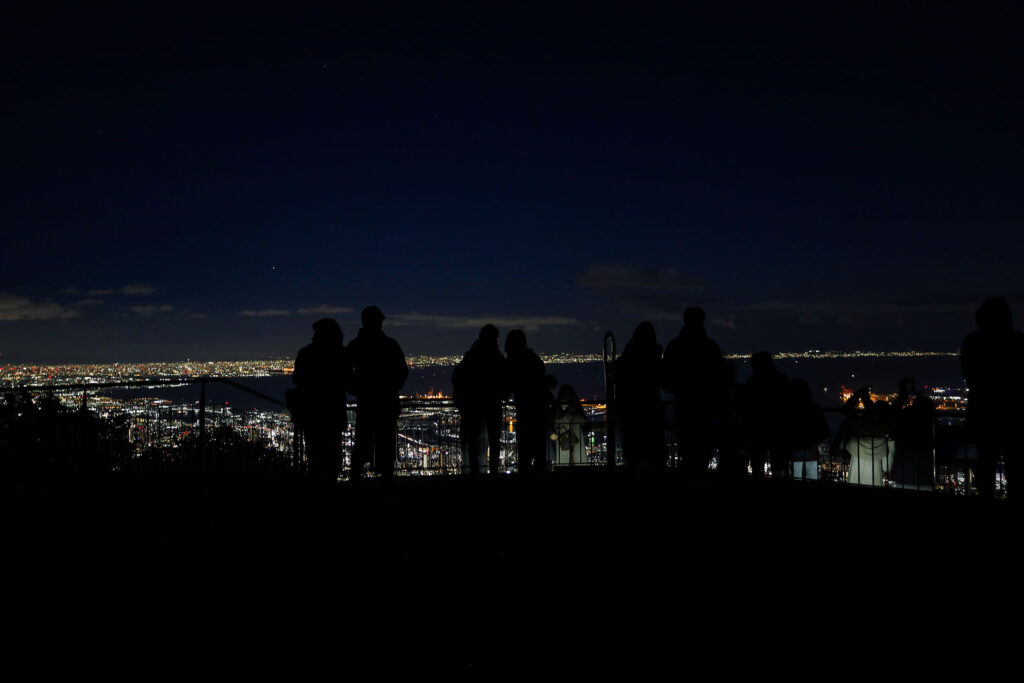
Night Walk Vol.71: Yaesu and Otsu
2023.03.24 & 04.21 Satoshi Tamura+ Amane Kotani+ Noriko Higashi+ Shouya Koizumi+ Moana Osakabe+ Hina Inagawa
The first Lighting Detectives activity of 2023 was a night walk survey in Yaesu, where Midtown Yaesu opened in March and large-scale development is planned for the future. They documented the pre-development area and at the same time looked around the new light environment in the area where development is underway. Mr. Suzuki of the Honda Foundation, whose building is scheduled for demolition, joined us on the survey and explained the history of the area and the Honda Building.
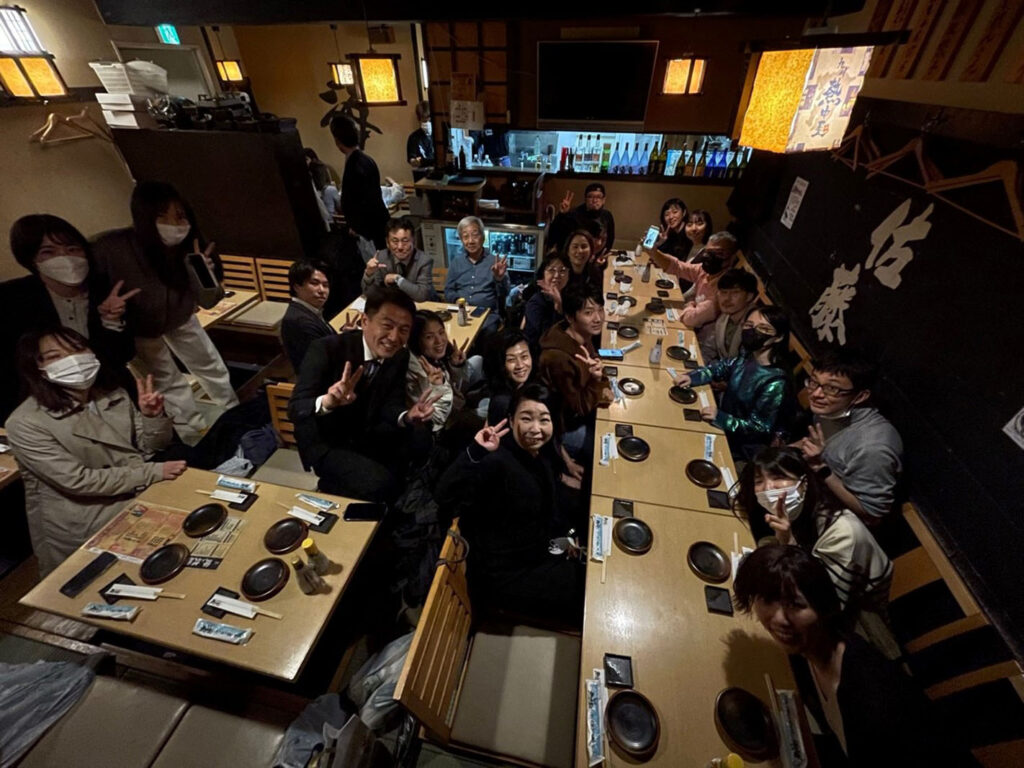
■ Group 1: North side of Yaesu Street
Group 1 toured mainly the north side of Yaesu Street. Although many areas were surrounded by temporary fences and inaccessible during redevelopment work, we were able to see the old drinking area and old buildings that were in use before the redevelopment. Although there were some villains in the old buildings, the drinking area was unanimously voted as a hero for its nostalgic impression with a moderate brightness of 55lx, 4,500K. The majority of the participants were of the opinion that they would like this townscape and atmosphere to remain in Yaesu after the redevelopment.
The greatest hero of the day was the rows of cherry trees along Sakura-dori Street. We were able to walk under them just as they were in full bloom on the day of night walk survey. Here, temporary lighting was installed later and the street lights were turned off, and although we could see the efforts being made to light up the cherry blossoms beautifully, it was debated there could be a better way to illuminate them. In some places, the surrounding environment such as road signs were unexpectedly bad, and we felt the
difficulty of lighting up natural objects. Some people also commented that it was good that the street lights were unified for each street. However, it was a little disappointing that many of the new street lights, which will become the symbol of the city in the future, had spotlights that illuminated directly under them with glare, or that the lanterns were not colored well, which were opinions more from the perspective of villains. The Yaesu Street Walk Survey this time allowed us to go around and document the city before it was newly renovated. Especially on the day of the survey, Mr. Suzuki of the Honda Foundation gave us an explanation of the area while we walked around the city, which was a very valuable experience for us and we truly appriciate it. We would definitely like to walk around the redeveloped and reborn Yaesu district and compare the two.
The final get-together was also a great success, as we were able to gather in large numbers and enjoy conversations as lively as the cherry blossoms. The weather, which had been a concern, held out long enough for us to do some research during the night walk survey, and it was very fulfilling. (Satoshi Tamura)
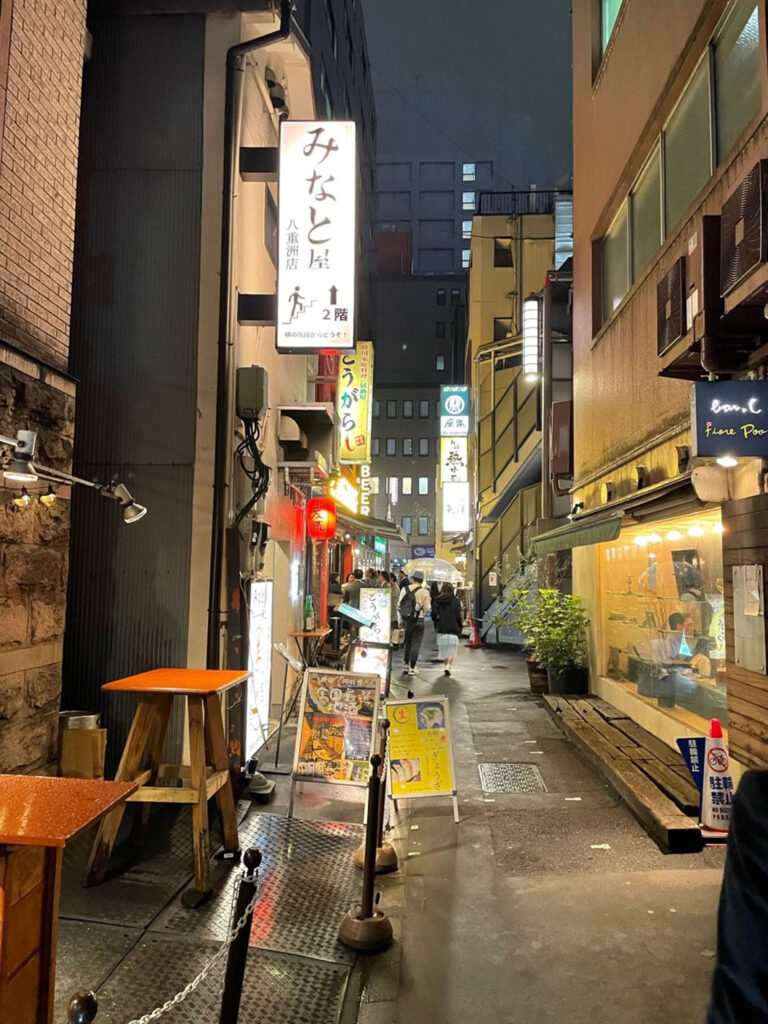
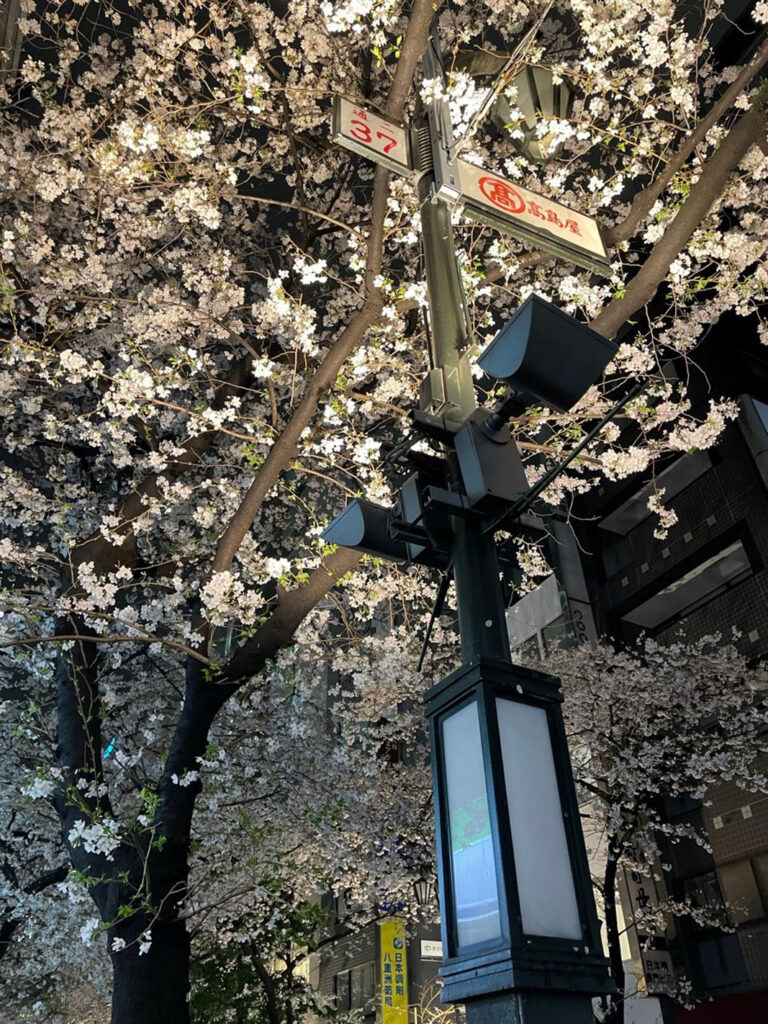
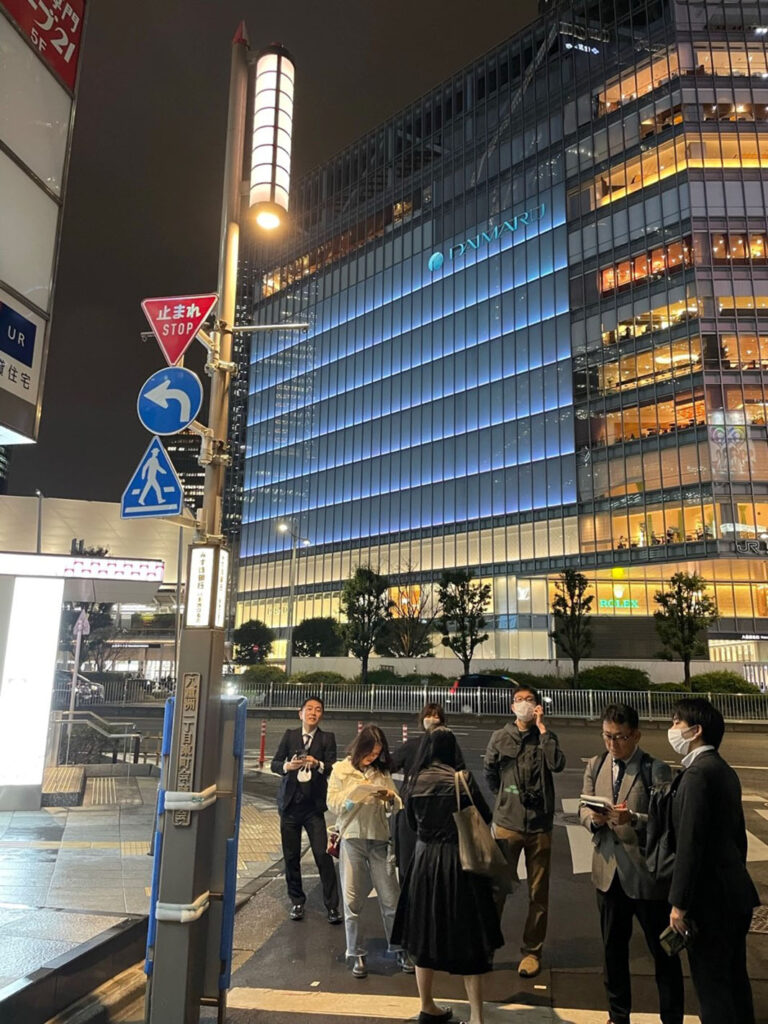
■ Group 2: Yaesu-Kyobashi Bridge
The second group walked around the area from Yaesu to Kyobashi Bridge. The lighting in a tavern on the way from Yaesu Book Center to Kyobashi Edogran was a typical example in Japan where the types of light bulbs and color temperatures were disorderly and just bright enough. It was a “villains” rating for what was a busy restaurant, which is a shame. While Kyobashi Edogran was designed with a lower color temperature overall, the escalator at the main entrance has a cold color and strong light. Participants commented, “It’s ruining the space.” What’s the point of insisting on an escalator?” Therefore, it was labeled as a villain. At Yaesu Midtown, we found a hero who looked like a Japanese person who was indifferent to lighting as the lights illuminating the wall surface reflected off the uneven wall material and created a waterfall. There was a fountain outside, so some people suggested that this might be a consistent expression of the staging theme of “water flowing.
At a construction site across from Yaesu Midtown, color-changing tape lights were used while monochromatic tape lights are usually used. The construction fence had “SDGs” written on it, and some people suggested that it might have been adopted to emphasize the SDGs. The winner was chosen as a hero because of the way the casual lighting gave meaning to the message rather than just using a display monitor to convey it.
Mr. Suzuki of the Honda Foundation explained to us that the height of buildings is regulated at 30 meters and that a dark place in the bright Yaesu district, with only a parking lot signboard light, is a rest area where tired working people naturally gather (whether it is good manners or not).
It was an enjoyable night walk survey through the city to “know, understand, and interpret the current situation of the city. (Amane Kotani)
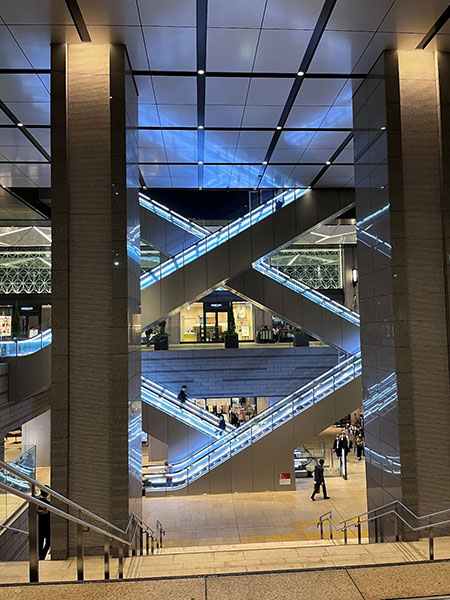
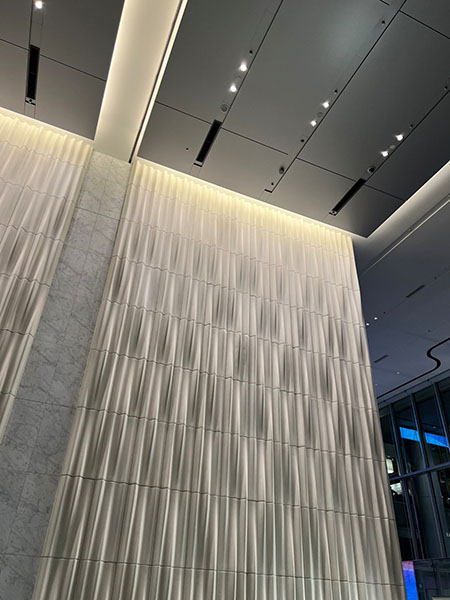
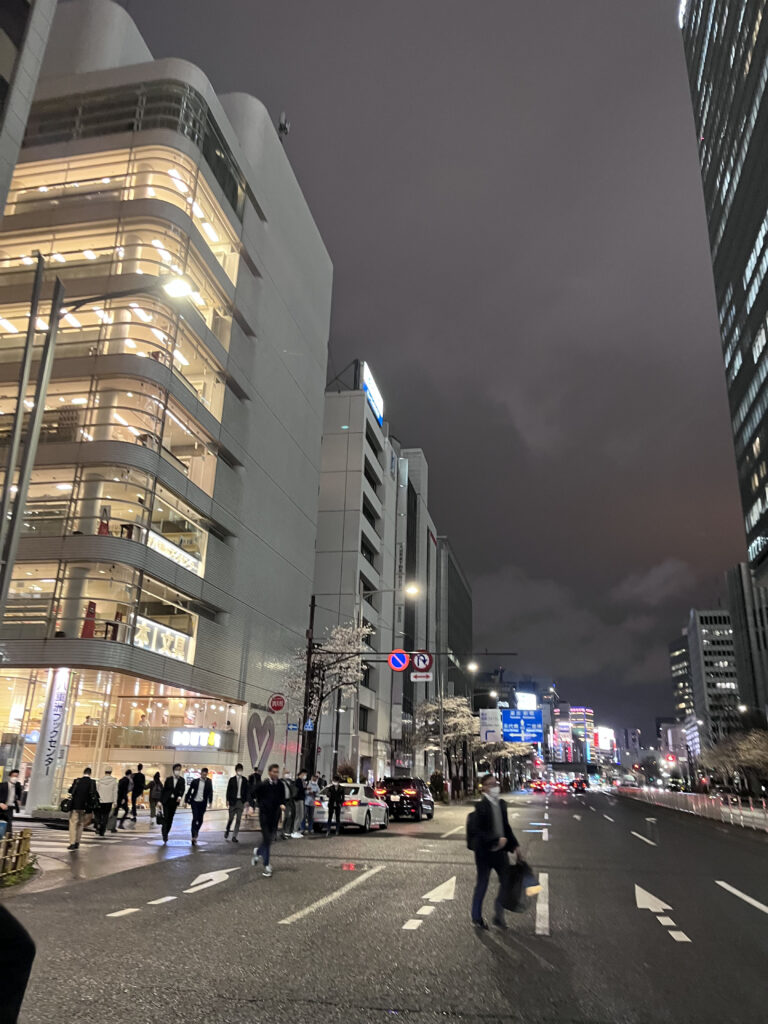
■ Group 3: Yaesu Underground Shopping Center Yaechika
Group 3 walked around the newly completed Midtown Yaesu and Yaechika, the Yaesu underground shopping mall.It was a Friday night and the cherry blossoms were in full bloom, so Yaesu was bustling with people at night, and it felt like the lively gateway to Tokyo had returned. The biggest villains found by Team 3 was the floodlights illuminating the Grand Roof, which caught our eyes when looking at Tokyo Station from the 5th floor hanging garden of Yaesu Midtown. The Grand Roof itself is nicely illuminated and has become an icon of the Yaesu Exit, but looking down from Midtown ruins the view from the high point. I don’t think that when the Grand Roof was first built, they did not envision the viewpoint from the high-rise building opposite, but I felt it was a waste of a very comfortable space with a great view.
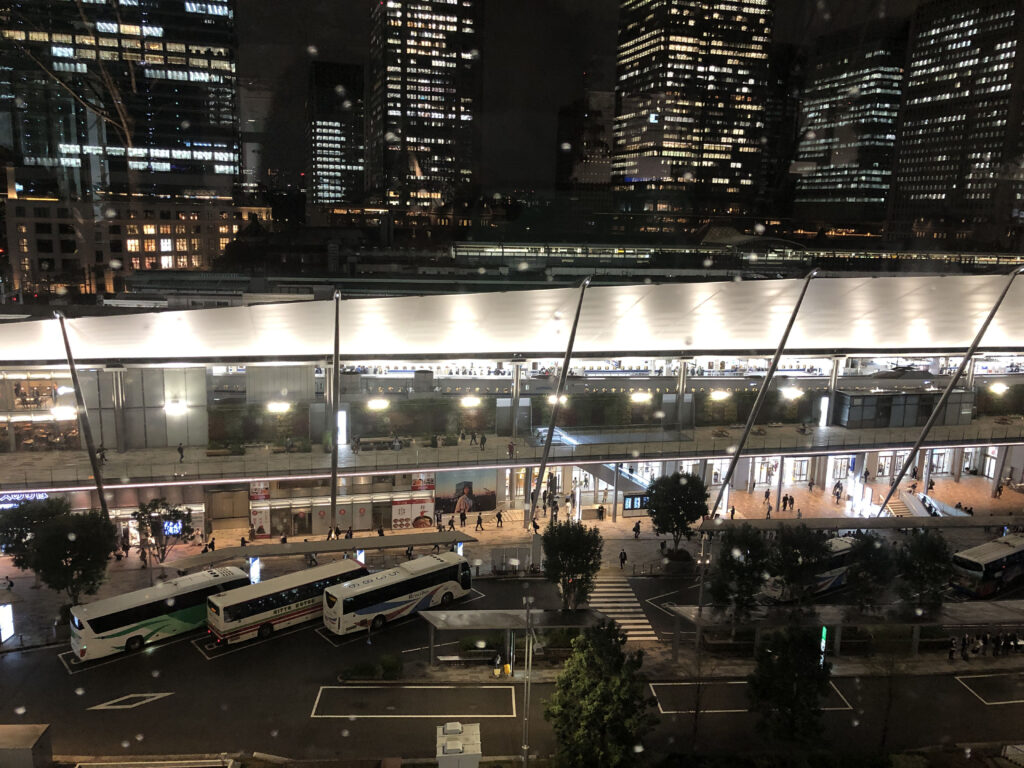
The plant-growing lighting in the Yanmar building atrium next to Midtown is the second villain. While this purple lighting may be essential for growing indoor plants, it was suggested that the lights could be turned on during unoccupied hours until the greenery grows and the fixtures are no longer visible.
In Yaechika, we found the remnants of a criminal. Looking up at the ceiling, we found a hole that was assumed to have contained compact fluorescent light bulbs lined up in various places. About 1/4 of them were now lit. Even so, the light was still too bright, at 1,200 lux. It is unimaginable to think how bright it would be if all the lights were on.
One of the heroes cited was the lighting of the hanging garden on the 5th floor of the Yaesu Midtown. The entire space was dimmed because of the light from the surrounding high-rise buildings, and the gentle foot lighting created a pleasant hanging garden. Many people said that the underground mall was villain in the common areas with its chiming downlights, but the vertical passageway became a hero because it was made up of only indirect lighting on the lines, making it a comfortable passageway without the oppressive feeling that is often associated with low ceilings and the glare of direct lighting.
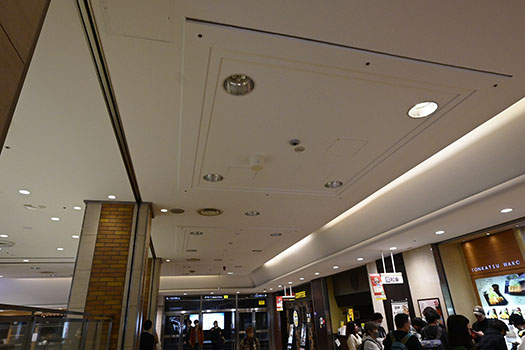
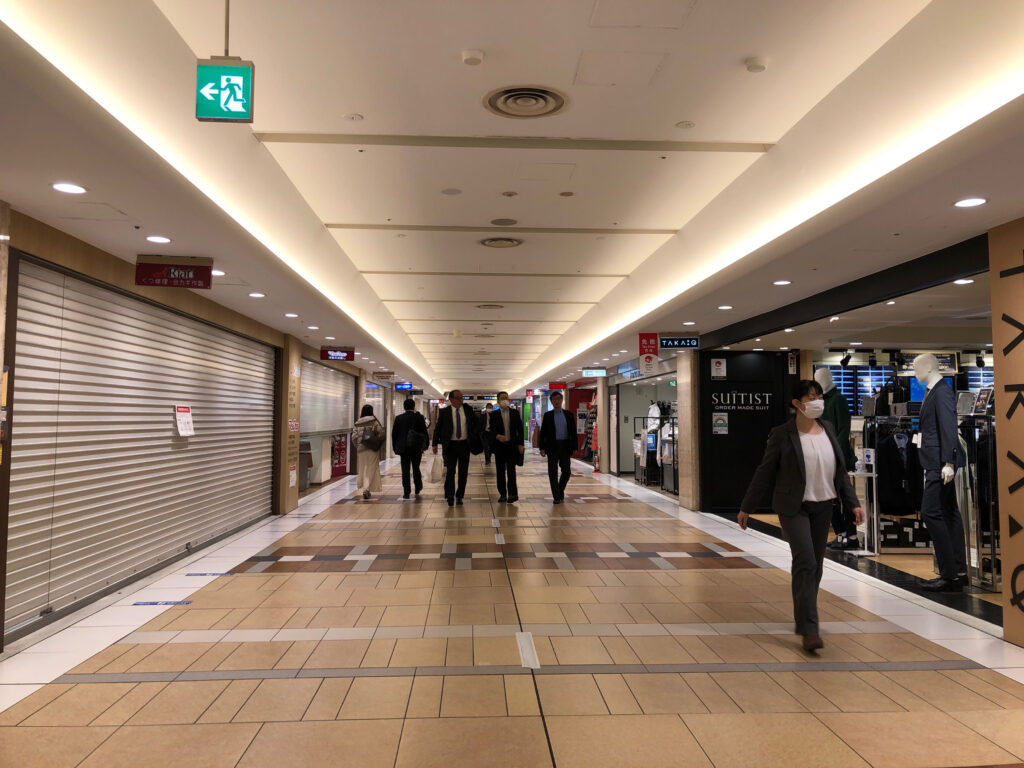
Although the weather was not good as it started raining heavily, we were able to enjoy the cherry blossoms in full bloom and the bustling Yaesu area. On the one hand, we were happy to see new buildings being completed and a sophisticated nightscape being created, but on the other hand, most of the participants probably wished that the lights of the red lanterns, which make you want to drop in on them, would remain forever. The fading scenery left us feeling a little sad as we walked through the town. (Noriko Higashi)
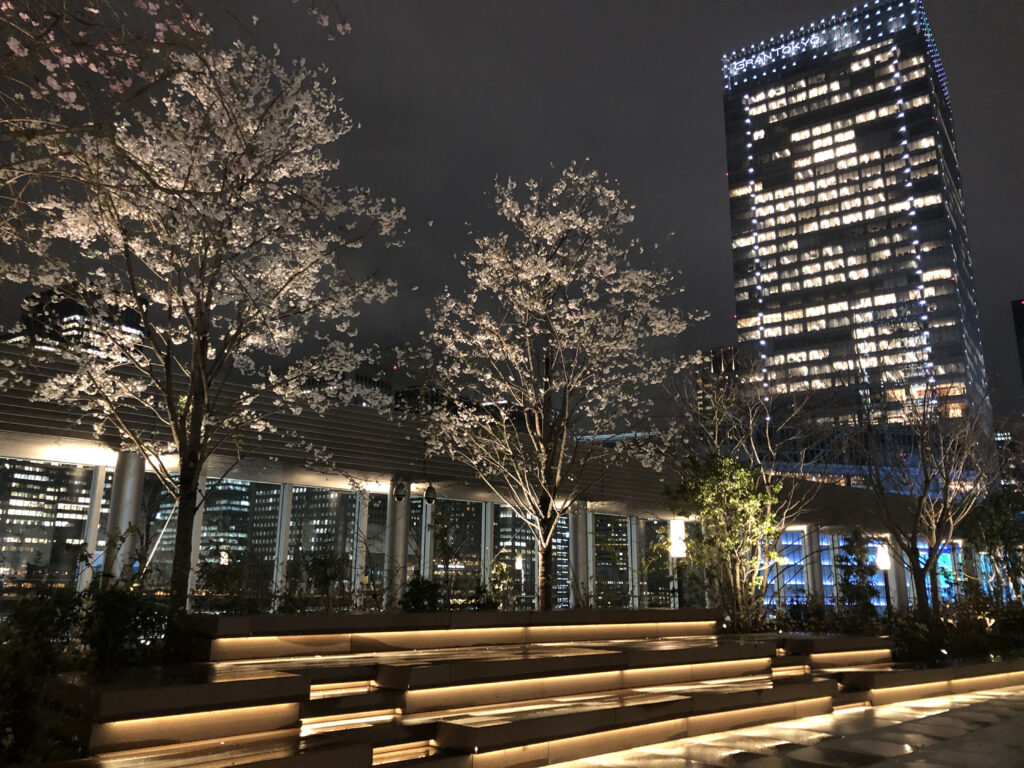
■Group Kansai : Otsu
This time, the group walked around the Otsu area in search of night views unique to the lake country, where Japan’s largest lake, Lake Biwa, and the Omi towns and nature surrounding it are woven together. The route took them from Biwako Hall to the Port of Otsu, walking along the lakeshore with a view of the opposite shore.
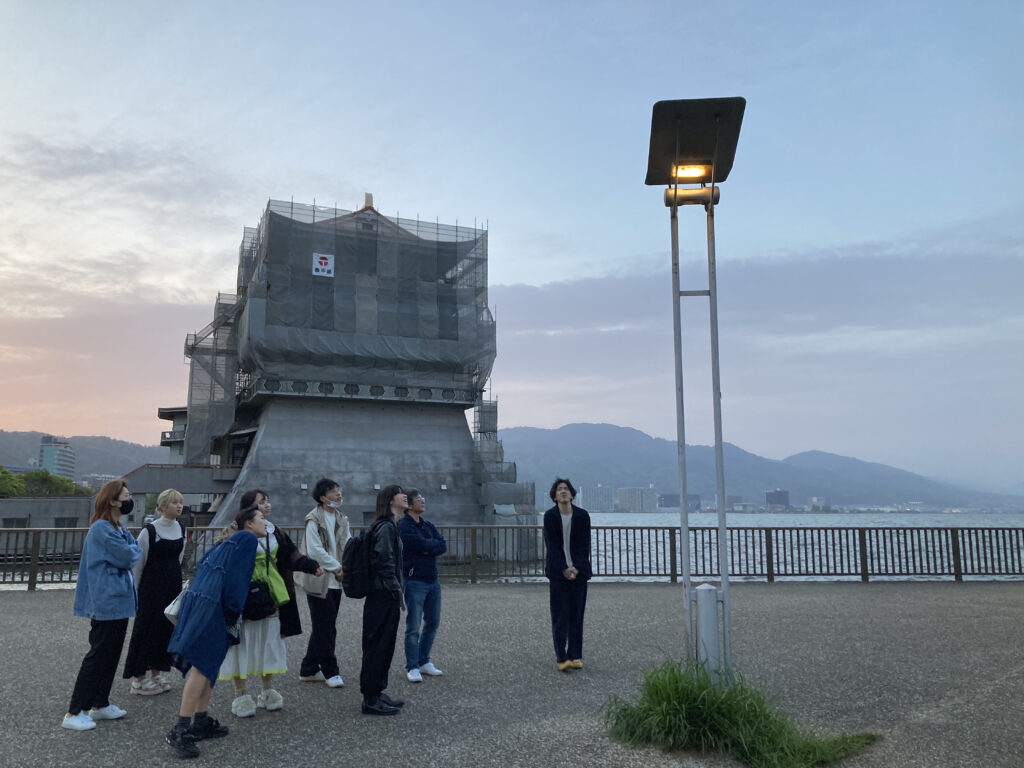
■Lighting on the horizon
After all, it is the largest lake in Japan, and it is rare to see such an expansive nightscape on the horizon. Unlike the ocean, the light is both near and far, a strange sensation. It was not as spectacular as the previous night walk survey in Kobe, but the lake gave me a sense of calmness instead of excitement.
■Pivoting lights along the shoreline
The road along the lakeshore was very dark and lonely due to the wide intervals between lighting installations. The lighting fixtures were well received with regard to design aspects, such as the spherical mechanics, somewhat reminiscent of a ship, and the ability to change angles by swinging the head. However, in our opinion, it was not streetlike, but rather violent, like a baseball night game where only brightness was needed. For the calm road along the lakeshore, a nostalgic sequence with a street-level design and warm colors would be a better fit.
As for the angle of the lighting, the fact that it only faced the road side and the Biwako Hall side was dark was well received by the adults, but we think it would be wonderful if there was a space where people could stay on the Biwako Hall side by illuminating it 360 degrees.
■Lake Biwa Floral Fountain
The Biwako Hana Fountain was a particular topic of discussion. It was lit up in poisonous colors of green and orange, and stood out among those mentioned as villains this time.
Suggestions for improvement from students
Inagawa: Some parts of the fountain look beautiful from certain angles. If it were illuminated in a single color, it would be beautiful from all angles.
Osakabe: The height and color of the fountain are different and there is no sense of unity. The colors should be matched.
Koizumi: The primary colors are too strong. Effects should be applied like projection with white light.
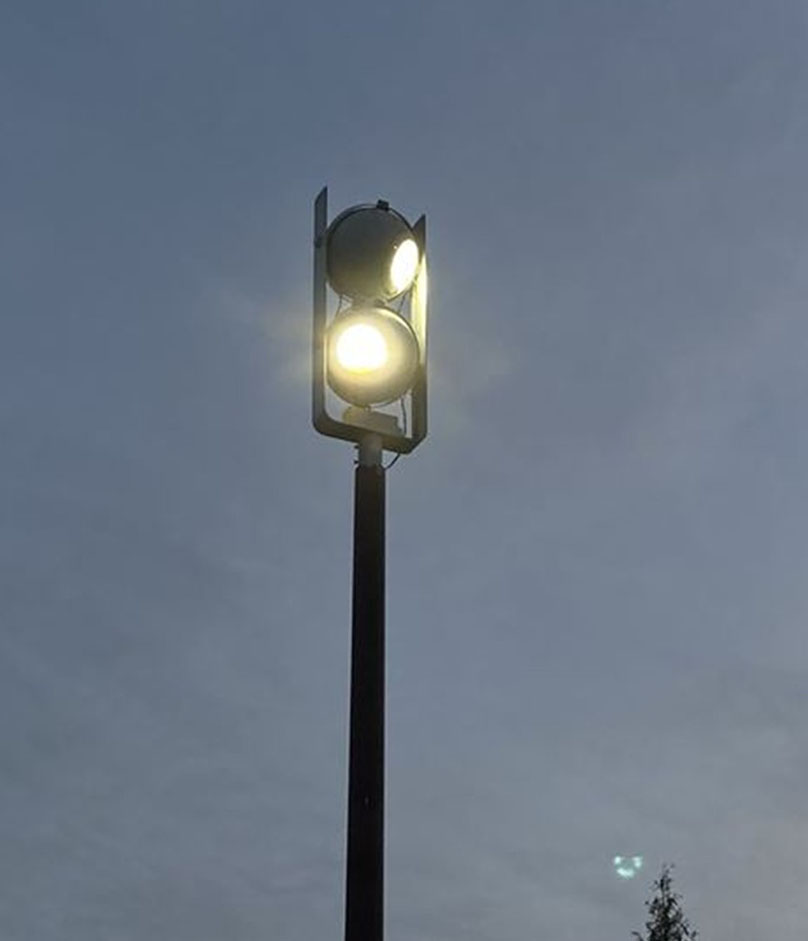
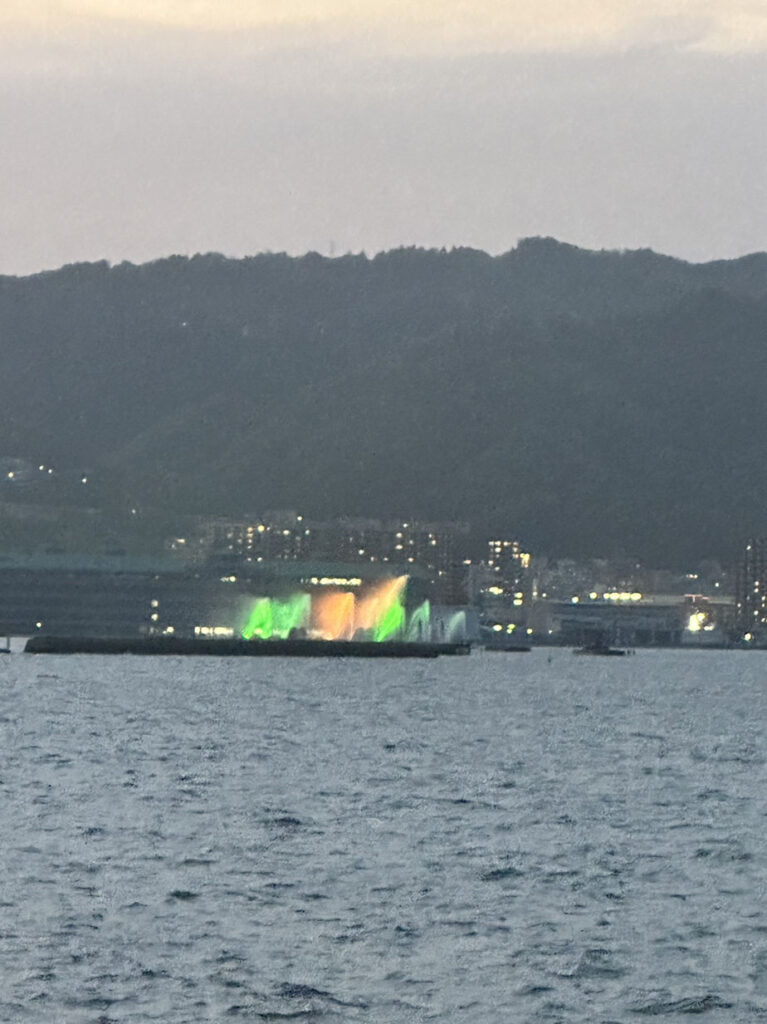
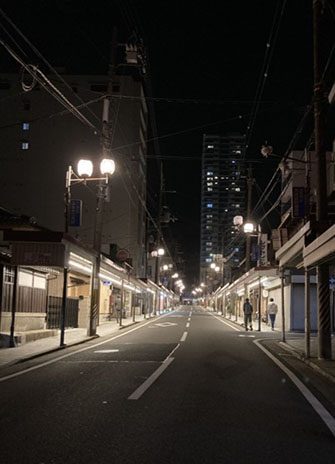
■Biwako Hall
Next is today’s main landmark, Biwako Hall. The light and dark spaces of the flow line are clearly defined, and the warm colors of the halogen lamps seem to match the relaxing atmosphere of Lake Biwa. However, it is regrettable that the halogen lamps are out in some places due to their short life span. Although it may not be intentional, the subtle unevenness of the wall tiles, which is not visible in the daytime, is highlighted by the lighting, creating a unique nighttime expression.
■Summary
This may sound like meddling, but it felt like that the roads along the lakeshore were generally dark and lacking in lighting, probably due to a lack of budget. As in any field, unless this bottleneck is eliminated, there is no place for design to play an active role. I think that designers will be required to be proactive in software from now on, without dismissing it as outside their field of expertise. (Shouya Koizumi, Moana Osakabe, Hina Inagawa)
Round Table Discussion Vol.69: Yaesu & Otsu Night Walk Review
2023.04.28 Noriko Higashi
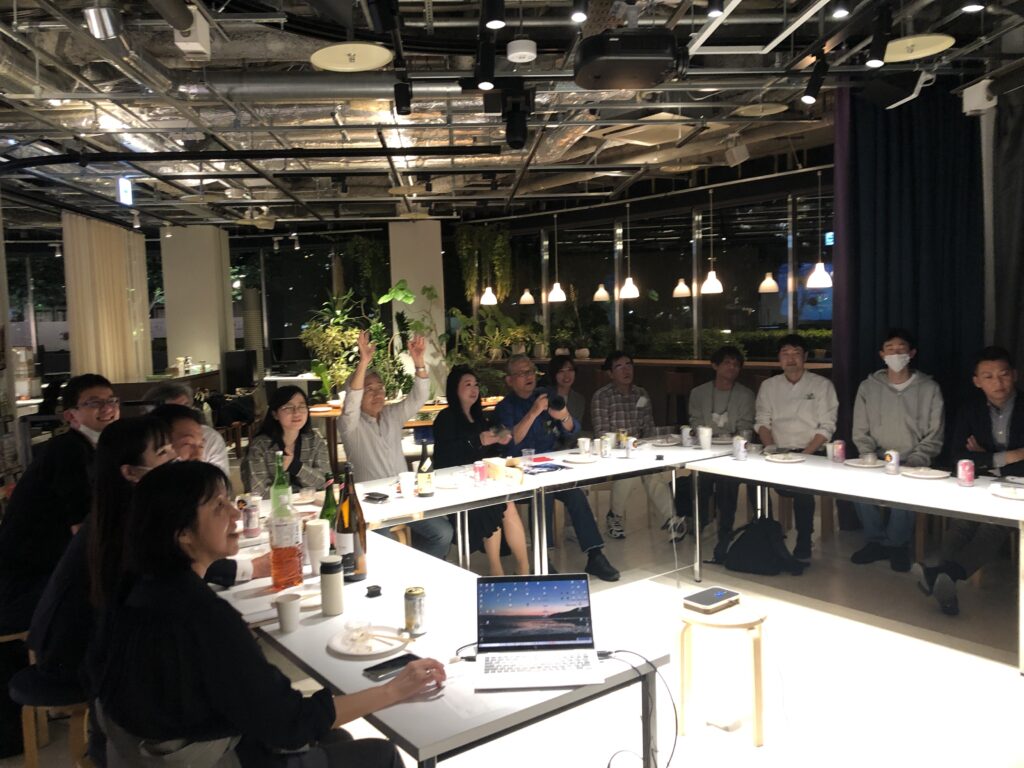
For the first time in about three years, the Lighting Detectives held an offline (actually a hybrid connecting with Kansai) Lighting Detectives Salon. This was the first salon since the Lighting Detectives office moved from Shibuya to Tsukuda. The excitement of the members who were eager to come to the new office was beyond imagination, so much so that I had to raise my voice a few times because I couldn’t hear the group members who participated online. The content of the salon was a review of the night walk survey in Yaesu and Otsu and a discussion of the theme for the next city walk.
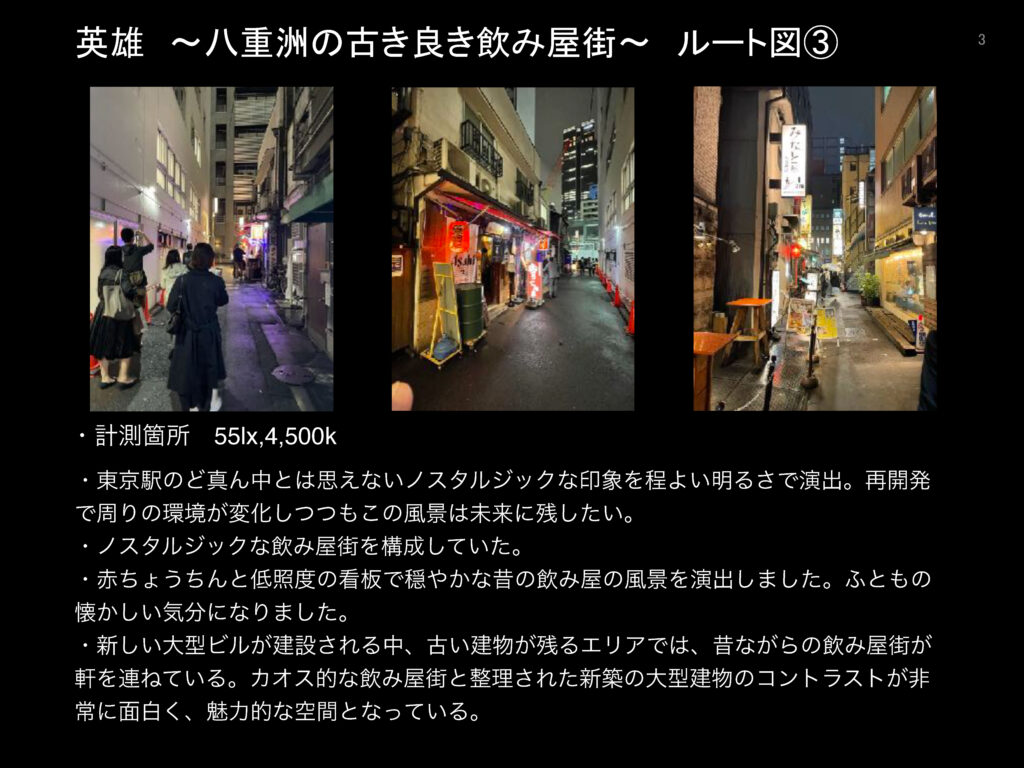
In the review of the Yaesu night walk survey, some people expressed their hope that the nostalgic red chochin lanterns with a rich Showa-era atmosphere that still exist in the midst of steadily advancing development would remain, there was a presentation on the various street lights in the Yaesu area, a review of handmade lights on the cherry blossoms that were just in full bloom, and a discussion of the light environment in the newly completed Yaesu Midtown and the Yaesu Underground Mall that is undergoing renovation.
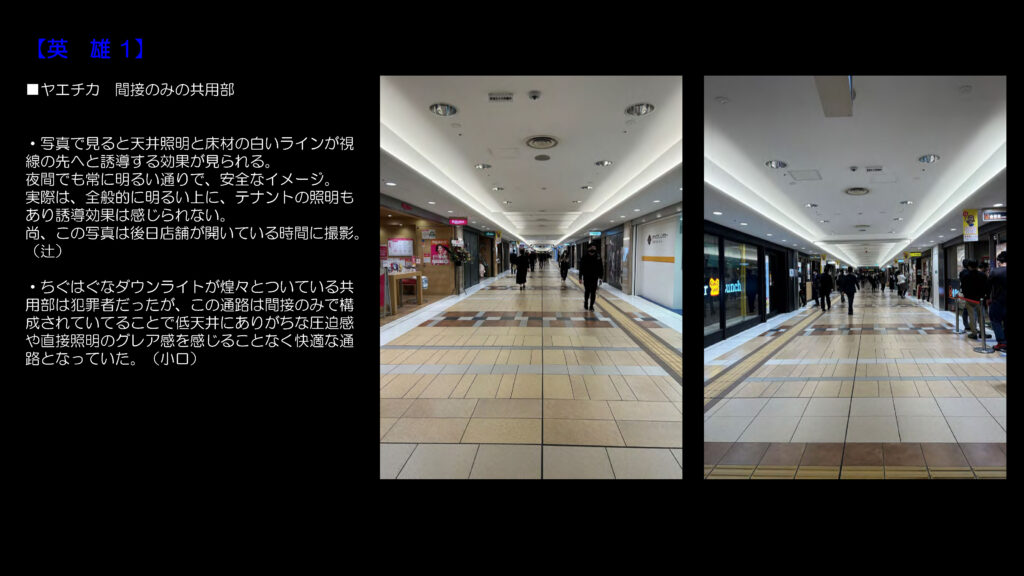
In the Otsu review, a student member of Ritsumeikan University who had just joined the group reported on the light environment along and around Lake Biwa. The color lighting of the Lake Biwa Hana Fountain reflected on the lake’s surface seemed to be the worst villain, which was disappointing despite the lighting was designed to create the atmosphere. In the review, several differences in the way new student members and non-student members of the group felt about lighting were raised, and it made me change my mind, which tends to get caught up in stereotypes.
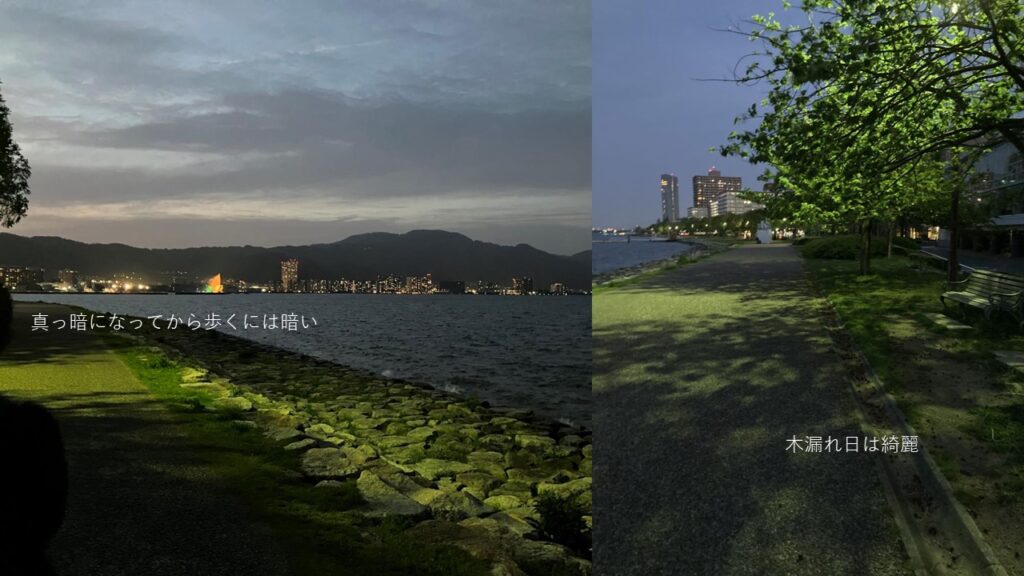
It has been a while since we had an offline salon, and I found the exchange of opinions more active than online. Online, everyone listens silently while each person expresses their opinion, but offline, discussions start next to each other, with different things being discussed here and there. It seemed the salon was back to its original state, as I enjoy the various discussions that take place in a less formal environment. However, those who participate online may not understand what is being discussed and may feel left out, so it would be necessary to devise a way to facilitate the discussion so that they do not feel left out.
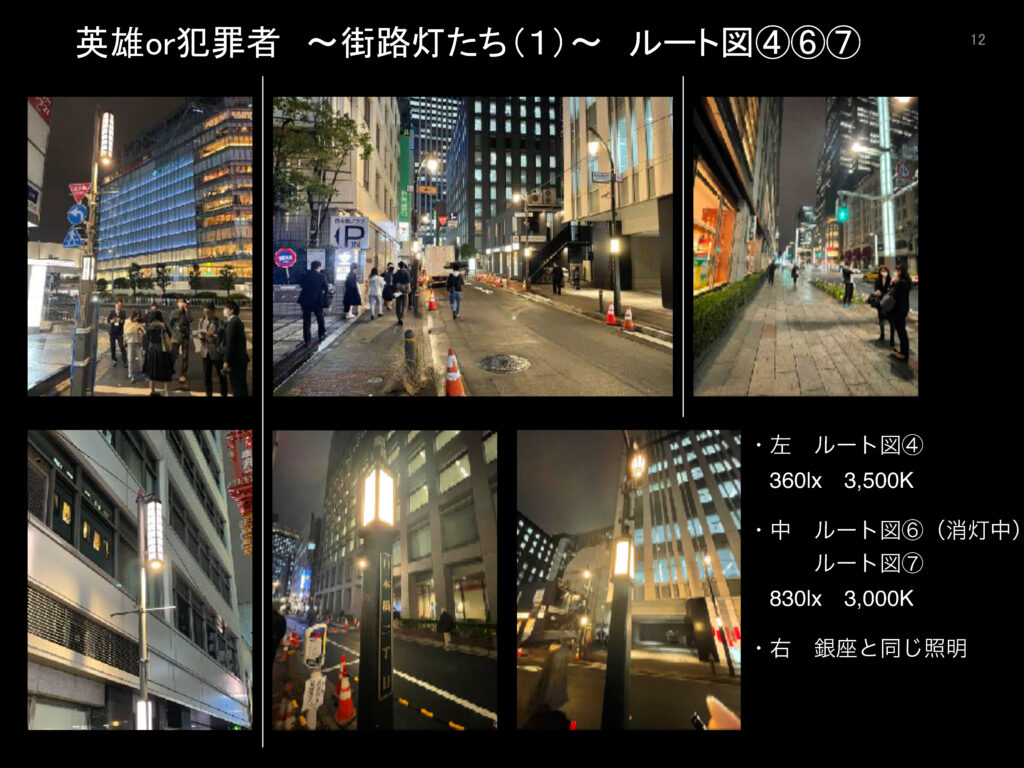
At the meeting, a suggestion was made that “since the Lighting Detectives’ night walk are always to see the light, how about going to see the darkness once in a while?” Everyone agreed with the idea and came to the conclusion that there would be “good darkness” and “bad darkness,” so continuing to discuss what kind of places could be found.
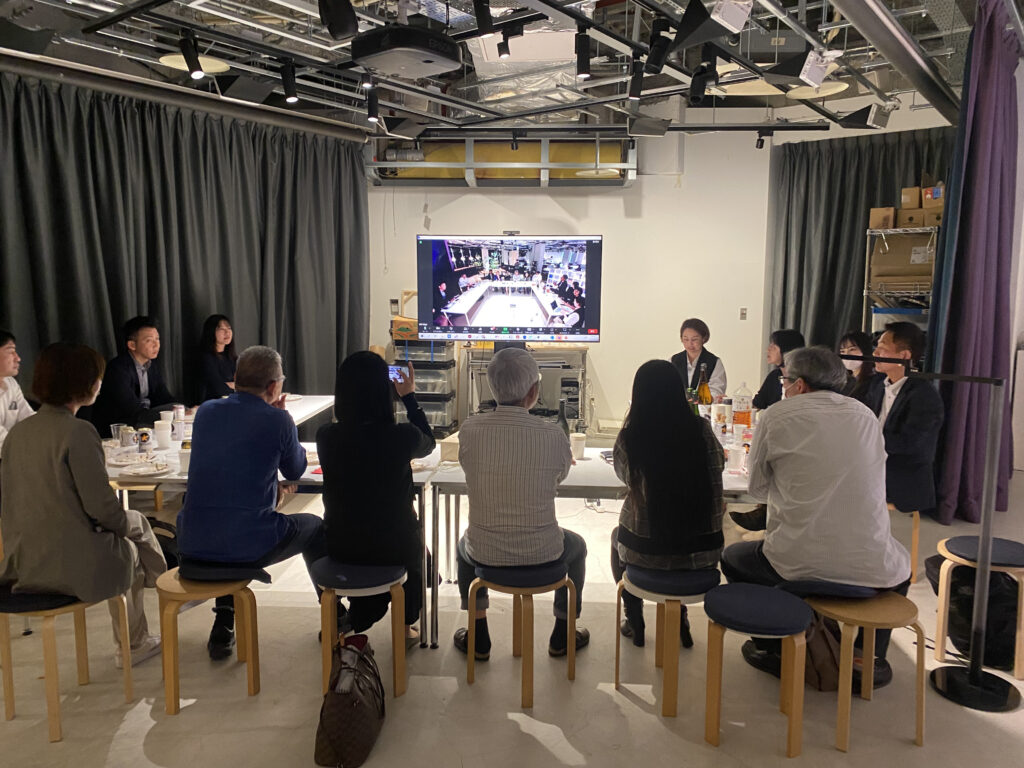
Please look forward to the next night walk, which will once again be divided between Kanto area and Kansai area, in search of darkness! (Noriko Higashi)





